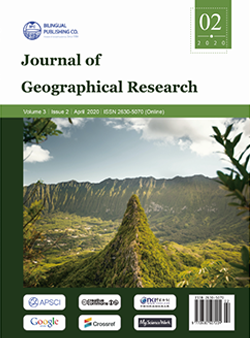-
11458
-
1935
-
1847
-
1712
-
1393
Soil Health and Sustainable Land Resource Management Practices at Municipal Level: A Case from Bheri Nagarpalika (Municipality), Jajorkot District, Nepal
DOI:
https://doi.org/10.30564/jgr.v3i2.2143Abstract
The increasing challenges of pressure and ever-growing demands on limited resources in Nepal by diverse actors, land degradation, biodiversity loss and climate change require the rational use of land resources to sustain and enhance productivity and maintain resilient ecosystems for achieving the sustainable and efficient use of resources, taking into account biophysical and socioeconomic dimensions. Regarding this, Nepal Government has realized and taken initiation of scientific and sustainable land use zoning following the National Land Use Act 2019 (2076 B.S.) to use land resources in practicable and sustainable manner. Using spatial information techniques such asZ-3 satellite image, remote sensing (RS), global positioning system (GPS) and geographic information system (GIS). Multicriteria decision making (MCDM) methods for acquiring spatial/temporal data, through expert judgment techniques based on field observation as well as laboratory analysis result, it was found that the soil nutrient status of, the municipality varied spatially and has pH with very high acidic to slightly alkaline but most of the soils are slightly acidic (39.58%). Majority of the soil are loam and sandy loam type with very low to high level of organic matter. Most of the municipal area is under medium range of organic matter. Nitrogen content ranges from very low to very high level as to same ranges of phosphorous (37.69%). Potassium level is also in very high to low as 37 percent land area has high level of potassium. Reclamation of acidic soil mainly in leachable soil is recommended with the proper management of Nitrogen with addition of organic matter is needed to manage for improving crop production.Keywords:
Land resource management, Agriculture sustainability, Soil properties, Organic matter, Land use planning and land use zoningReferences
[1] National Planning Commission (NPC). Nepal human development report 2014: Beyond geography,unlocking human potential. Kathmandu: Government of Nepal/ National Planning Commission, 2014
[2] Carson, B., Shah, P.B, Maharjan, P.L. Land systems report, the soil landscapes of Nepal, Ottowa:Kenting Earth Sciences,1986.
[3] Molla Mekonnen Alemu. Sustainable land management. Journal of Environmental Protection, 2016,7:502-506.http://www.scirp.org/journal/jephttp://dx.doi.org/10.4236/jep.2016.74045
[4] Federal Government of Nepal (FGN). National Land Use Act,2020.Kathmandu: FGN, 2020.
[5] Choudhury, J., Jansen, L.J.M. Terminology for integrated resources planning and management.Rome:-Food and Agriculture Organization/United Nations Environmental Program, 1999.
[6] Pokhrel, K.P. Chure forestry conservation and management plan: A case study of Arghakhanchi district,Nepal. Journal of Geography and Regional Planning,2013, 6(5):172-183.
[7] Andoh, H.F.; Antwi B.O., et. al. Estimation of soil erodibility and rainfall erosive patterns in the agro ecological zones of Ghana, Journal of Soil Science and Environmental Management, 2012, 3(11):275-279.
[8] Jensen J. R. Introductory digital image processing: A remote sensing perspective (3rd edn). Upper Saddle River: Prentice-Hall, NJ, 2005.
[9] Kaveh, D., Mazlan, H. Very high resolution optical satellites for DEM generation: a review.European Journal of Scientific Research, 2011, 49(4): 542-554 ISSN: 1450-216X
[10] Lamar, A. Zoning as taxidermy: Neighborhood conservation districts and the regulation of aesthetics. Indiana Law Journal, 2015.
[11] LRMP. Land utilization report. Kathmandu: LRMP.Government of Nepal/Government of Canada–Kenting Earth Sciences Limited,1986.
[12] Selby M.J. Hill slope materials and processes. 2nd edition. London: Oxford University Press, 1993:xv+ 451.ISBN: 0-19-874183-9
[13] Noe, C. Reducing Land Degradation on the Highlands of Kilimanjaro Region: A Biogeographical Perspective.Open Journal of Soil Science, 2014, 4: 437-445.
[14] Science for Environment Policy (SEP). Integrating Environmental Risk Assessment. Thematic Issue 53.Issue produced for the European Commission DG Environment by the Science Communication Unit,UWE, Bristol, 2015. Available at:http://ec.europa.eu/science-environment-policy
[15] C.B.S. National population and housing census 2011:VDC/ Nagarpalika repor,. Jajorkot.Kathmandu:National Planning Commission/ Central Bureau of Statistics, 2014.
[16] Ministry of Agricultural Development (MOAD). Statistical information on Nepalese agriculture 2016/17.Kathmandu: Agri Statistics section, MOAD/GON,2018.
[17] United States of department of Agriculture (USDA).Keys to soil taxonomy. 14th Edition. United Washington DC: USDA,2010
[18] Verma, V.K; Patel’ L.B., Sharma P.K. Spatial distribution of macronutrients in soils of Arid Tract of Punjab, India. Int. J. Agri. Biol., 2005, 7(2): 295-297.
Downloads
How to Cite
Issue
Article Type
License
Copyright © 2020 Kabi Prasad Pokhrel

This is an open access article under the Creative Commons Attribution-NonCommercial 4.0 International (CC BY-NC 4.0) License.




 Kabi Prasad Pokhrel
Kabi Prasad Pokhrel





